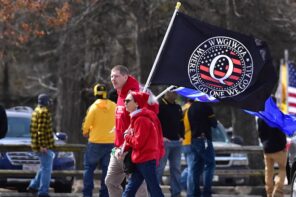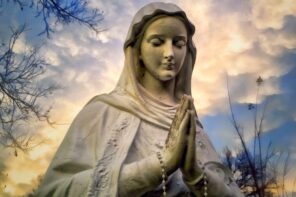Every June 18 for more than 25 years, Veronica Lueken—a Catholic housewife from Bayside, Queens—gathered followers for an all-night vigil beside the Unisphere in Flushing Meadows-Corona Park. In a trance, Lueken transmitted apocalyptic messages from the Virgin Mary, whose visitations were labeled ”Our Lady of the Roses.” Lueken died in 1995, and her followers split into factions that feuded over control. — New York Times, July 26, 1998
1. What inspired you to write The Seer of Bayside?
Believe it or not, my interest in Veronica Lueken developed naturally from my first book on vampires. I learned about Lueken because one of her messages from heaven talked about vampires and warned that there really are possessed people who walk among us and drink human blood.
It’s sometimes said that the job of a religion scholar is to render “the strange familiar and the familiar strange.” As I investigated further, I found a lot of literature framing Veronica Lueken as a “kook” and her followers as weirdoes. But dismissing a religious group as weirdoes is just intellectual laziness. Religious worldviews are like stained glass windows: you can only appreciate them when you see them from the inside. I wanted to find that inside perspective so that the strange could be rendered familiar.
2. What’s the most important take-home message for readers?
I want readers to think critically about why some religious movements and institutions seem “normal” and others seem strange. Most people regard the Baysiders as a “fringe” Catholic group. But from the Baysiders’ perspective, they are the normal Catholics and it is everyone else who has deviated from tradition.
In thinking about this problem, I invoke Benedict Anderson’s notion of “imagined communities.” The boundaries of Catholic tradition are imagined; no one can actually see all the different ways there are to be Catholic throughout the world, so we have to imagine where the boundary is that separates “normal” Catholic belief and practice from deviant belief and practice. Most people take these definitional boundaries for granted. But the truth is that these boundaries are socially constructed and have always been contested. What we imagine as normative is actually the result of a conflict in which one party seized the power to define what normal is.
I see the story of the Baysiders as a struggle to define what the core values of Catholicism are in the wake of Vatican II. For the most part, the Baysiders lost that battle, but their story reveals some of the motivations of lay Catholics and the tactics they can use to assert their own understanding of their tradition.
3. Is there anything you had to leave out?
There are thousands of Baysiders and none of them are boring. One tangent I was sad to leave out is the 2009 documentary Cropsey in which the Baysiders have a brief cameo. While investigating a series of child murders in Staten Island allegedly carried out by Andre Rand, the documentarians found that in 1987 Veronica Lueken sent an anonymous letter to the parents of one of the victims alleging that Rand was abducting children to sacrifice in Satanic black masses.
This is significant because, according to journalist Maury Terry, Lueken also made anonymous phone calls to reporters investigating the Son of Sam murders. She offered information connecting David Berkowitz to a Satanic cult. I’m very interested in Satanic Panic and it seems that the Baysiders had a major role in disseminating urban legends that serial killers are part of an organized network of murderous cultists.
4. What are some of the biggest misconceptions about your topic?
We often assume that we can know about religious practitioners simply by reading their sacred text. This is almost never true. If you simply open Veronica Lueken’s prophecies to a random page and read about Freemasons and UFOs, it’s easy to assume that all Baysiders are paranoid and hysterical. But when I did my ethnography I found that most Baysiders were pleasant, reasonable people.
I also found that Baysiders exerted a lot of agency in terms of what they believed and how they practiced. Some seemed more interested in conspiracy theories about the Vatican or the various disasters Lueken predicted. But others seemed to enjoy Baysider vigils simply because the ritual made them feel close to Mary, Jesus, and God in a way that traditional Catholic services did not.
5. Did you have a specific audience in mind when writing?
In all of my writing I try to be both scholarly and accessible. I hope that anyone interested in Marian apparitions or Catholic culture would find this book enjoyable. As far as a larger scholarly conversation, I hope this book will help steer the study of American religious history away from what has been called a “two-tier” model of religion.
Historians like Robert Orsi have argued that scholars have implicitly made a distinction between “true religion” and various subcategories like cults, folk piety, superstition, etc. I don’t think the Baysiders are a “side show” in the field of religious studies and I think the history of the Baysiders helps us to think about how we tacitly make these sorts of judgments.
6. Are you hoping to just inform readers? Entertain them? Piss them off?
I do think the history of the Baysiders is an amazing story that has never been properly told. So part of my job as a historian is just to “tell a good yarn.” But I am also trying to be fair in how I tell the story. In his work on Scientology, Hugh Urban describes trying to balance a “hermeneutics of suspicion” with a “hermeneutics of respect.” I faced a similar dilemma.
Much of what has been written about the Baysiders has been either from the perspective of theologians representing the Catholic hierarchy or the anti-cult movement. No one has really tried to put a human face on this group. At the same time, I am not an apologist for the Baysiders. I do not endorse their truth claims or agree with their politics. So I am trying to strike a balance. It may be that both Catholic authorities and Baysiders will be take issue with how I told the story. If both sides are equally annoyed then I did my job right.
7. What alternative title would you give the book?
My original title was “Until Our Church Hears Us.” I thought this title captures the strange relationship the Baysiders have with their Church. They are not a schismatic group and express a deep longing to be reconciled with Church authorities. But, as my wonderful editor pointed out, this title doesn’t effectively convey what the book is actually about.
8. How do you feel about the cover?
I think it’s great! There are so many wonderful photos of Veronica out there. Unfortunately it was hard to track down permission to use most of them. I think the one on the cover makes it possible to imagine what it would have been like to attend a Baysider vigil when Lueken was in her prime.
9. Is there a book out there you wish you had written? Which one? Why?
At the moment, I’m a little jealous of Benjamin Zeller’s new book Heavens Gate: America’s UFO Religion. During the Cold War, UFOs really were an important part of America’s religious imagination. You can see this in some of Lueken’s prophecies that account for UFOs. There have been several good books on UFO religions but I think there is a lot more to explore. I also admire Zeller for humanizing a group that the public has been very dismissive of.
10. What’s your next book?
My next book is called Dangerous Games: What the Moral Panic Over Role-Playing Games Says About Religion, Play, and Imagined Worlds (University of California Press, 2015). It should come out in February. This book was a labor of love and I’m very excited about it. It explores why games of the imagination like Dungeons and Dragons became such a source of panic to conservative Christians during the 1980s. I think this book will be very cathartic for anyone from my generation who felt persecuted because their beloved hobby was dubbed Satanic.





